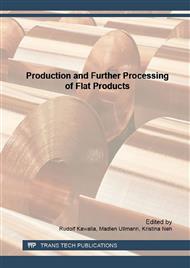p.3
p.9
p.16
p.22
p.29
p.35
p.42
p.51
Effect of Parameters in the Physical Simulated Rough Rolling Stage on Microstructure Evaluation and Tensile Properties of a Bainitic Pipeline Steel
Abstract:
Microstructure evolution and tensile properties were studied in a bainitic pipeline steel grade by performing a number of physical simulations on samples machined out of an industrially produced transfer bar. In these simulations, the cooling interval between roughing and finishing stages (tV) was varied from 5 s to 180 s. The austenite status after this cooling interval, regarding the prior austenite grain size and precipitates, simulates the condition of austenite before entering the finishing mill. The finishing parameters and the subsequent cooling strategy were kept unchanged throughout all the applied simulation processes. The gradual increase in tV resulted in a gradual increase of the granular bainite phase on the expense of the aciculare ferrite. This resulted in an incremental decrease in ultimate tensile strength and yield strength with increasing tV. However, this behavior approached a steady state condition after which the tV has limited/insignificant effect on the ultimate-and yield strength. This saturating value of tV is process parameter dependent.
Info:
Periodical:
Pages:
3-8
Citation:
Online since:
May 2016
Authors:
Permissions:
Share:
Citation:


